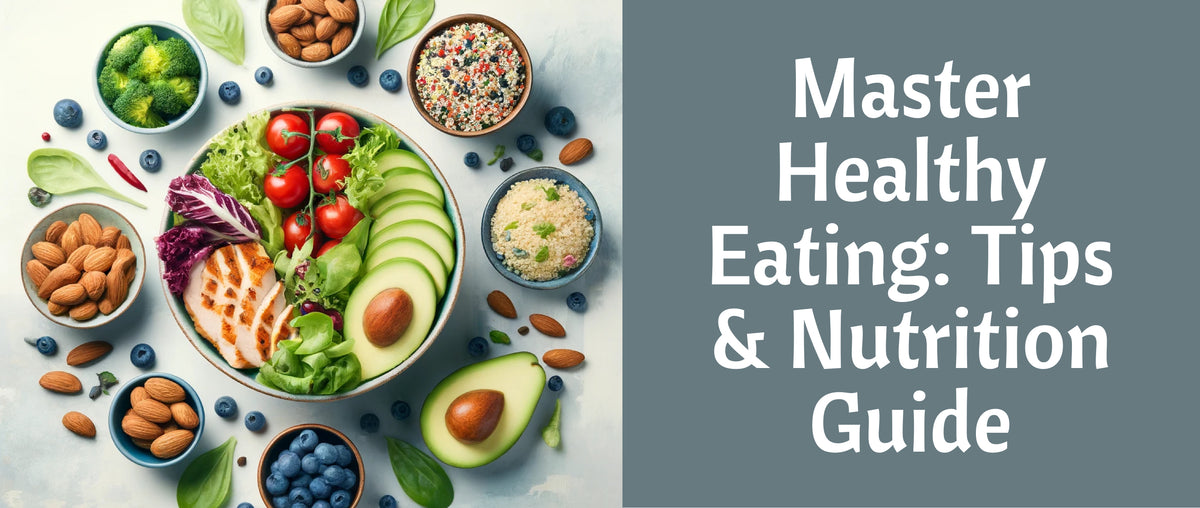Guide to Healthy Eating on a Budget
healthy eating is crucial for maintaining overall well-being, but many people believe that eating well is expensive. The truth is, with careful planning and smart shopping, you can enjoy a healthy diet without breaking the bank. This guide will show you how to eat healthily on a budget, ensuring you get the nutrients you need without overspending.
Key Takeaways
- Plan meals ahead of time to avoid impulsive and costly purchases.
- Create a detailed shopping list to stay focused and reduce food waste.
- Choose affordable, nutrient-dense foods like whole grains, beans, and seasonal produce.
- Cook at home and make use of leftovers to save money and ensure healthy eating.
Planning and Preparation
Meal Planning
Meal planning is a powerful tool for maintaining a healthy diet on a budget. By planning your meals in advance, you can avoid impulsive purchases and ensure that you have all the ingredients you need for nutritious meals throughout the week.
The benefits of meal planning are numerous. It saves time and reduces stress, minimizes food waste, helps maintain a balanced diet, and keeps you within your budget.
How to Create a Meal Plan:
1. Assess Your Week: Look at your weekly schedule and determine how many meals you need to prepare.
2. Choose Recipes: Select recipes that are simple, nutritious, and use overlapping ingredients.
3. Make a Shopping List: Write down all the ingredients you'll need, grouping them by section of the grocery store.
4. Prep Ahead: Prepare ingredients in advance, such as chopping vegetables or cooking grains, to save time during the week.
Creating a Shopping List
A well-thought-out shopping list is essential for eating healthy on a budget. It helps you stay focused and avoid unnecessary purchases, ensuring you buy only what you need for your planned meals.
The importance of a shopping list cannot be overstated. It keeps you organized, reduces food waste, helps you stick to your budget, and prevents impulsive buying.
How to Build an Effective Shopping List:
- Check Your Pantry: Before heading to the store, check what you already have at home.
- Categorize Items: Organize your list by sections of the store (produce, dairy, grains, etc.) to make shopping more efficient.
- Include Basics: Always have staples like whole grains, beans, and frozen vegetables on hand.
- Stick to the List: Avoid deviating from your list to prevent unnecessary spending.
Don't Shop When You're Hungry
One simple but effective tip for healthy eating on a budget is to avoid shopping when you're hungry. Hunger can lead to impulsive buying and unhealthy choices, such as sugary snacks or highly processed foods.

Smart Shopping Tips
Buy in Bulk
Buying in bulk can be a cost-effective way to stock up on staples like grains, beans, nuts, and seeds. Bulk purchases often come at a lower price per unit, making it easier to maintain a healthy diet without overspending.
Shop Seasonally
Seasonal produce is often fresher, more nutritious, and less expensive than out-of-season options. By choosing seasonal fruits and vegetables, you can enjoy a variety of flavors while sticking to your budget.
Use Discounts and Coupons
Take advantage of discounts, sales, and coupons to save money on groceries. Many stores offer loyalty programs that provide additional savings and special offers on plant based foods.
Avoid Processed Foods
Highly processed foods are often more expensive and less nutritious than whole foods. Focus on buying whole, unprocessed ingredients to make nutritious meals at home.
Shop at Local Markets
Local farmers' markets can be a great source of fresh, affordable produce. Shopping locally supports small businesses and can provide access to high-quality, seasonal ingredients.
Avoid Buying Highly Processed Food
Highly processed foods, such as sugary snacks, frozen dinners, and instant noodles, are not only more expensive but also less nutritious. By focusing on whole foods, you can maintain a healthy diet and save money.
Affordable Nutrient-Dense Foods
Eating a healthy diet on a budget means focusing on nutrient-dense foods that provide the most nutrition for the least cost. Here are some affordable options:
Whole Grains
Whole grains are an excellent source of fiber, vitamins, and minerals. They are also budget-friendly and versatile in many dishes. Examples of whole grains include brown rice, quinoa, oats, barley, and whole wheat pasta.
Beans and Legumes
Beans and legumes are packed with protein, fiber, and essential nutrients. They are also one of the most cost-effective sources of protein. Affordable options include black beans, lentils, chickpeas, pinto beans, and kidney beans.
Seasonal Fruits and Vegetables
Buying fruits and vegetables in season can significantly reduce costs while ensuring you get fresh, flavorful produce. For example, in spring, you can enjoy asparagus, strawberries, and spinach. In summer, tomatoes, zucchini, and blueberries are abundant. Fall brings squash, apples, and sweet potatoes, while winter offers citrus fruits, kale, and Brussels sprouts.
Affordable Protein Sources
Protein is essential for muscle recovery and overall health. There are many budget-friendly options available. Inexpensive protein sources include eggs, canned tuna or salmon, tofu, tempeh, and vegan cheese from Grabenord.
Cooking at Home
Cooking at home is one of the best ways to ensure you’re eating nutritious meals while staying within your budget. It allows you to control ingredients and portion sizes, leading to healthier eating habits.
Benefits of Cooking at Home
Cooking at home offers several advantages. It saves money, allows for nutritional control by choosing healthier ingredients, and helps with portion control, reducing the risk of overeating.
Simple and Nutritious Recipes
Creating simple and nutritious meals doesn't have to be complicated. Here are a few ideas:
Healthy Snacks for Kids:
- Apple slices with almond butter
- Carrot sticks with hummus
- Homemade trail mix with nuts and dried fruit
High Protein Snacks:
- Greek yogurt with berries
- Hard-boiled eggs
- Cottage cheese with sliced vegetables
Batch Cooking and Freezing
Batch cooking is an efficient way to prepare meals in advance, saving time and money. Cooking large portions and freezing them for later use ensures you always have healthy meals ready.
Batch Cooking Tips:
- Prepare large quantities of staples like rice, beans, and roasted vegetables.
- Portion meals into single-serving containers for easy grab-and-go options.
- Label containers with the date and contents to keep track of your meals.
Utilizing Leftovers
Using leftovers creatively can reduce food waste and stretch your grocery budget further. Transform leftovers into new dishes to keep meals interesting.
Ideas for Using Leftovers:
- Leftover roasted vegetables can be added to salads or omelets.
- Cooked grains like rice or quinoa can be repurposed into stir-fries or grain bowls.
- Leftover proteins can be used in soups, stews, or sandwiches.
Reducing Food Waste
Reducing food waste is not only good for the environment but also helps you save money. By properly storing food and creatively using leftovers, you can maximize the value of your grocery purchases.
Proper Food Storage
Properly storing food can extend its shelf life and prevent spoilage. Here are some tips for effective food storage:
- Refrigerate perishables: Store items like dairy, meats, and certain fruits and vegetables in the refrigerator to keep them fresh longer.
- Use airtight containers: Store dry goods such as grains, beans, and nuts in airtight containers to prevent moisture and pests.
- Freeze for later: Freeze leftovers and bulk-cooked meals to preserve them for future use.
Creative Use of Leftovers
Utilizing leftovers can save both time and money. Here are some ways to repurpose leftovers into new, delicious meals:
- Soups and Stews: Leftover vegetables, grains, and proteins can be combined into hearty soups and stews.
- Stir-Fries: Use leftover rice or noodles along with veggies and proteins for a quick stir-fry.
- Sandwiches and Wraps: Transform leftover meats and veggies into tasty sandwiches or wraps for an easy lunch option.
Composting
Composting is an excellent way to reduce food waste and create nutrient-rich soil for gardening. Composting helps divert food scraps from landfills and can provide a sustainable resource for growing your own produce.

Additional Tips for Eating Healthy on a Budget
Staying Hydrated
Staying hydrated is essential for overall health, and water is the most cost-effective drink. To keep it interesting, you can infuse water with fruits like lemon, lime, or berries.
Healthy Snacks
Snacking can be part of a healthy diet if you choose nutritious options. Here are some healthy snacks for kids and adults:
- Fresh fruit
- High protein snacks like nuts and seeds
- Veggie sticks with hummus
- Low calorie food options like air-popped popcorn
Avoiding Sugary Drinks and Junk Food
Sugary drinks and junk food are often expensive and provide little nutritional value. By avoiding these items, you can save money and improve your health. Opt for Healthy Drinks like water, herbal teas, or Kombucha.
The Challenge of Eating Well on a Budget
Eating well on a budget can be challenging due to the perceived high cost of nutritious foods and the temptation of cheap, unhealthy options. However, with careful planning and smart shopping, it's entirely possible to eat healthily without spending a fortune.
Eating Healthy for Less Is About More Than Just the Cost of Food
It's important to remember that eating healthy for less is about more than just the cost of food. It's also about making sustainable choices, reducing waste, and focusing on nutrient-dense options that provide the best value for your money.
How to Eat Healthily on a Budget
Incorporating these tips into your routine can help you eat healthily on a budget. Focus on meal planning, smart shopping, and cooking at home to maximize your grocery budget and ensure a nutritious diet.
How to Eat Healthily on a Budget
Incorporating these tips and learning from others' experiences can make a significant impact. Remember, eating healthy on a budget is achievable with the right strategies and mindset.
Conclusion
Eating healthily on a budget is not only possible but also rewarding. By planning meals, making smart shopping choices, and focusing on nutrient-dense foods, you can enjoy a healthy diet without overspending. Remember to:
- Plan your meals and create a detailed shopping list.
- Buy in bulk and shop seasonally.
- Avoid processed foods and sugary drinks.
- Cook at home and make use of leftovers.
Implement these tips, and you'll find that maintaining a nutritious diet is both affordable and enjoyable. Start today, and see the positive changes in your health and wallet.
Do you enjoy vegan food? We have a list of vegan restaurants in India to help you find delicious options in your area!










